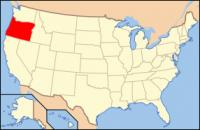|
|
|
Oregon (c-enaudio=en-us-Oregon is a state in the Pacific Northwest region of the United States. It is located on the Pacific coast, with Washington to the north, California to the south, Nevada on the southeast and Idaho to the east. The Columbia and Snake rivers delineate much of Oregon's northern and eastern boundaries, respectively. The area was inhabited by many indigenous tribes before the arrival of traders, explorers, and settlers who formed an autonomous government in Oregon Country in 1843. The Oregon Territory was created in 1848, and Oregon became the 33rd state on February 14, 1859. Salem is the state's capital and third-most-populous city; Portland is the most populous. Oregon's 2010 population is just over 3.8 million, a 12% increase over 2000. Portland is the 29th-largest U.S. city, with a population of 583,776 (2010 US Census) and a metro population of 2,241,841 (2009 estimate), the 23rd-largest U.S. metro area. The valley of the Willamette River in western Oregon is the state's most densely populated area and is home to eight of the ten most populous cities. Oregon contains a diverse landscape including the windswept Pacific coastline, the volcanoes of the rugged and glaciated Cascade Mountain Range, many waterfalls (including Multnomah Falls), dense evergreen forests, mixed forests and deciduous forests at lower elevations, and high desert across much of the eastern portion of the state, extending into the Great Basin. The tall Douglas firs and redwoods along the rainy Western Oregon coast contrast with the lower density and fire prone pine tree and juniper forests covering portions of the eastern half of the state. Alder trees are common in the west and fix nitrogen for the conifers and aspen groves are common in eastern Oregon. Stretching east from Central Oregon, the state also includes semi-arid shrublands, prairies, deserts, steppes, and meadows. Mount Hood is the highest point in the state at 11249 ft (3428.7 m). Crater Lake National Park is the only national park in Oregon. |




 RSS
RSS